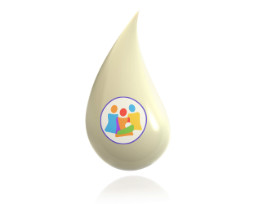Providing Human Milk: Does it Really Matter?
Numerous medical and public health organizations have position statements and websites devoted to lactation, which cite extensive research on the health benefits of breastfeeding for both mothers and infants.
Breastfeeding Rates in 2018
Medical and public health experts recommend that babies be exclusively breastfed for 6 months, with breastfeeding to continue for at least 2 years for optimal maternal and child health outcomes per the American Academy of Family Medicine breastfeeding position statement and the World Health Organization Infant and Young Child Feeding Statement. This means that babies should receive only breastmilk and not other foods such as solids, formula or water the first 6 months of life. After 6 months of age, babies should continue to breastfeed, while adding complementary foods.
Breastfeeding rates in the United States were lowest in the 1960’s and 70’s. In past 20-30 years, extensive research and community support have resulted in a steady increase in the number of parents who breastfeed. In 2018, according to the US Centers for Disease Control Breastfeeding Statistics, 83.9% of parents nationwide initiated breastfeeding, 25.8% were exclusively breastfeeding at 6 months, and 35% breastfed for at least 1 year.
Infant Health Benefits
Breastfeeding has been shown to reduce the risk of ear infections, diarrhea, and pneumonia. Babies who breastfeed also are less likely to have eczema, asthma under age 7, childhood obesity, type II diabetes, childhood leukemia, sudden infant death syndrome (SIDS) and necrotizing enterocolitis. Breastfed children score higher on cognitive testing throughout childhood.
Maternal Health Benefits
Breastfeeding is important for maternal health. Breastfeeding is associated with a decreased risk of breast, ovarian and endometrial cancer. Women who breastfeed are at lower risk for cardiovascular diseases as they get older, as well as type 2 diabetes mellitus. For example, breastfeeding is associated with lower risk of stroke, heart attacks, high cholesterol, high blood pressure, and less accumulation of fat in the belly.
Human Milk
Human milk is rich in a variety of proteins that not only fight infection (such as antibodies), but also mature certain organs such as the brain and intestines. Maturation of the brain leads to higher IQ and earlier retinal development. Breastmilk also moderates inflammation, so that breastfed infants don’t become as ill when fighting infections.
Nutritionally, breastmilk is designed with the right balance of fat, carbohydrates, water and proteins to ensure optimal growth and development. Babies digest human milk easily, and its composition changes over time to match the nutritional needs of the growing infant. Breastmilk responds to illnesses that the infant and/or mother have, by making antibodies to the germs that are causing the infection, so that the antibodies can protect the infant from severe disease.
Human milk has not been duplicated in the laboratory setting. Researchers continue to identify previously-unknown components in human milk, along with their function, to help us understand the complicated and unique relationship between breastmilk and maternal/child health.
Benefits to Society
- Parents miss less work when their babies are fed human milk. The Affordable Care Act amended the U.S. Fair Labor Standards Act in 2010 to require employers to provide private space and reasonable breaks for lactating parents of infants under one year of age.
- If 90% of US mothers would exclusively breastfeed for the recommended six months, nearly 1,000 infant deaths could be prevented and the US would save $13 billion a year in health care costs. Breastfed infants require fewer sick care visits, prescriptions and hospitalization.
- Per a 2021 CDC study, initiating breastfeeding is associated with a 26% reduced risk of death for infants aged 7-364 days. Breastfeeding was found to reduce infant deaths related to infections, sudden unexpcted infant death (SUID), and necrotizing enterocolitis (NEC).
- Formula feeding results in a large environmental footprint due to transportation and production costs involved with converting cow’s milk to a digestible formula for human infants.
- Breastfeeding or providing your milk can reduce the costs of feeding your infant. When low income women breastfeed, they are more self-sufficient and require fewer food program subsidies. Formula is a $4 billion industry and is projected to grow to an almost $6 billion industry by 2027. In the USA, 50% of formula is purchased by the federal government with taxpayer dollars and distributed via the Women Infant and Children (WIC) food supplement program. If a parent does not qualify for WIC, a family will need to purchase ~$1,500-$3,000 worth of formula annually to feed their baby. While the lactating parent’s time is not “free”, providing your milk to your baby can result in significant cost savings and decreased missed work and daycare. By developing appropriate support and holding employers accountable to current federal law, families can reduce their financial burden.
- Directly feeding your infant is designed to calm and quiet a baby. Many social scientists feel that the intimacy of direct feeding is linked to increased brain development and enhanced social skills that are vital in today’s rapidly changing world.


